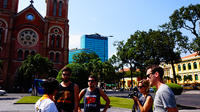Private Half-Day Ho Chi Minh City Tour by Motorbike
Ho Chi Minh City, Vietnam
Trip Type: Vespa, Scooter & Moped Tours
Duration: 3 hours
Ride with our motorbike drivers on the roads of Ho Chi Minh City. This trip is great for anyone who is interested in sightseeing and learning more about the rich history Vietnam has to offer.
More About This Activity All Vespa, Scooter & Moped Tours →
Ride with our motorbike drivers on the roads of Ho Chi Minh City. This trip is great for anyone who is interested in sightseeing and learning more about the rich history Vietnam has to offer.Led by a team of international certified tour guides, our goal is to bring you fun, safe, and informative adventures by motorbikes and cars in and around Ho Chi Minh City. All of our tours are 100% private - a way of ensuring you have plenty of time to ask our certified guides questions and get to see what you want to see at your own pace.
You will have the opportunity to visit some of these admirable places, including but not limited to:
Reunification Palace. This landmark dates back to 1868 that was originally built by the French, which marked the newly established colony of Indochina. It was not until 1962 when two Vietnamese rebel pilots bombed the building that the president had ordered a new construction - named the Independence Palace. However, in 1975 the Viet Cong rampaged down its iron gates that Vietnam has been “reunified.” Since then, the building is known as the Reunification Palace. Today, this place has become of political and cultural significance.
Notre Dame Cathedral. French colonists constructed this cathedral between 1863 and 1880. The materials used, including the bricks and stained glass windows, were all imported from France and tourists can still view most of its originality.
Central Post Office. French architect Gustave Eiffel created this magnificent building that resembles a traditional European railway station in the late 1880s. The post office is one of the busiest and working governmental structures in the country.
Temples and Pagodas. These unique architectural buildings - some at least 300 years old! - reflect the innumerous diverse religions in Vietnam. Often, the best way to avoid the urban’s hectic noise is to visit one of these places to restore and regain the balance in our lives.
War Remnant Museum. History is written by the victors. Learn more about the Vietnam War from the Vietnamese's side of the story by visiting one of the most popular exhibits in Vietnam.
You will have the opportunity to visit some of these admirable places, including but not limited to:
Reunification Palace. This landmark dates back to 1868 that was originally built by the French, which marked the newly established colony of Indochina. It was not until 1962 when two Vietnamese rebel pilots bombed the building that the president had ordered a new construction - named the Independence Palace. However, in 1975 the Viet Cong rampaged down its iron gates that Vietnam has been “reunified.” Since then, the building is known as the Reunification Palace. Today, this place has become of political and cultural significance.
Notre Dame Cathedral. French colonists constructed this cathedral between 1863 and 1880. The materials used, including the bricks and stained glass windows, were all imported from France and tourists can still view most of its originality.
Central Post Office. French architect Gustave Eiffel created this magnificent building that resembles a traditional European railway station in the late 1880s. The post office is one of the busiest and working governmental structures in the country.
Temples and Pagodas. These unique architectural buildings - some at least 300 years old! - reflect the innumerous diverse religions in Vietnam. Often, the best way to avoid the urban’s hectic noise is to visit one of these places to restore and regain the balance in our lives.
War Remnant Museum. History is written by the victors. Learn more about the Vietnam War from the Vietnamese's side of the story by visiting one of the most popular exhibits in Vietnam.
« Go Back

